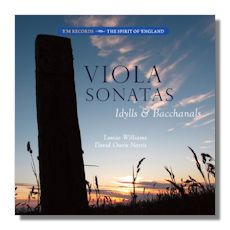
The Internet's Premier Classical Music Source
Related Links
-
Bax Reviews
Maconchy Reviews
Jacob Reviews
Rawsthorne Reviews
Milford Reviews
Leighton Reviews - Latest Reviews
- More Reviews
-
By Composer
-
Collections
DVD & Blu-ray
Books
Concert Reviews
Articles/Interviews
Software
Audio
Search Amazon
Recommended Links
Site News
 CD Review
CD Review
Idylls & Bacchanals

English Viola Sonatas
- John McEwen:
- Viola Sonata #7 in A minor (1941)
- Improvisations provençales for Violin & Piano (1937)
- Breath o' June (1913)
- Arnold Bax: Viola Sonata
- Elizabeth Maconchy: Viola Sonata
- Gordon Jacob: Sonatina for Viola and Piano
- Alan Rawsthorne: Viola Sonata
- Robin Milford: Four Pieces for Viola and Piano, Op. 42
- Kenneth Leighton: Fantasia on B-A-C-H, Op. 29
Louise Williams, viola & violin
David Owen Norris, piano
EM Records EMR-CD007-008 2CDs 69:39+64:15
As one of the commentators for this release, the pianist David Owen Norris explains the choice of subtitle for the album by saying that "something about the character of the combination of viola and piano seems to have driven the composers to extremes of expression…. And as it happens, the three numbers that are not Sonatas, with their pastoral lyricism, may well be considered idyllic." Given the mellowness of the sonority of the viola, I find his assertion about extremes of expression dubious, but I can definitely agree with the latter part of his characterization. Both "Idyll" and "bacchanal" come from the ancient pastoral tradition. The relative calm and peacefulness of the works on disc one (McEwen and Bax) certainly confirms the idyllic designation. Bacchanal suggests unbridled excitement. The works on disc two are often exciting, certainly in contrast with the previous, but I don't think the unbridled condition quite applies. And there is some excitement in the Bax and the McEwen; as well as calm beauty in the slow movements by the composers on disc two.
Sir John McEwen (1868-1948) was Scottish. He studied and worked in Glasgow, in addition to studying at the Royal College of Music. In addition to nineteen string quartets, he is known for his Solway Symphony (1909-1911) and some other orchestral works. McEwen's A Minor Sonata is in four movements, the first being by far the longest, and features a Scottish reel, spritely and cheery, but with more serious interludes – "recitatives," Norris calls them. The movement ends quietly and the slow movement enters similarly. The Andante espressivo is a pentatonic melody, beautiful as well as gentle. Norris notes that the melody is "punctuated by ghostly fanfares." The Allegretto is lively and the sound of the viol especially rich; Norris calls it "a more stately yet paradoxically busier dance. The Finale is molto vivace. McEwen's six-part Improvisations, based on songs, are varied in tempo, pitch, phrasing and mood: "The Heavy Heart" is poignant; "The Old Trees" features an intense violin and a very deliberate piano; Oouliveio is sad, even a bit dirge-like and with a bell-like accompaniment; "The Piper" is simple and cheerful. The lyrical work Breath O' June has harp-like rippling sounds.
Sir Arnold Bax (1883-1953) is well-known for his tone poems and symphonies. The opening movement of his 1922 Sonata gives us a rich, full-toned broad melody from the viola against staccato piano notes. The middle movement, designated Allegro energico, is especially appealing for its energy and rhythms. Perhaps surprisingly, this is followed by a finale which is very slow.
Dame Elizabeth Maconchy (1907-1994) grew up in Ireland, studied in London with Vaughan Williams, did further studies in Prague, and was influenced by Janacek and Bartok. Her orchestral suite The Land, which does not appear to be available on a recording at present, was highly acclaimed in her time. In her Sonata, I find especially appealing the delicate sounds in the beautiful and gentle Lento moderato.
Gordon Jacob (1895-1984), born in London, attended the Royal College of Music and later taught there. His students included Malcolm Arnold and Imogen Holst. A note by Trevor Arrowsmith and Robin Sawers characterizes his music as closer to neoclassicism than to the English "pastoral" school. His Sonatina might suggest otherwise to some. It includes a very gentle, quiet and expressive slow movement between a cheery opening and a lively concluding movement.
Alan Rawsthorne (1905-1971), from Lancashire, studied at the Royal Manchester College of Music, after which he studied abroad with the pianist Egon Petri. Among other things he wrote a musical setting of T.S. Eliot's Practical Cats. His Second Symphony is designated "Pastoral." In the four-movement Sonata for Viola and Piano the viola and piano seem to go their own way for a time but in the third movement Adagio the viola is accompanied on the beat. The Scherzo is quite fast and the final Rondo-Allegro comodo is both lively and pleasant.
Robin Milford's (1903-1959) Four Pieces (all brief) open with a gentle Air, followed by a gently upbeat Musette with minimal variation of the melody. The Serenade has pleasant long lines but with some emphatic phrasing, and the final Gavot [so spelled] has a catchy tune and strong rhythmic accents.
Kenneth Leighton's (1929-1988) fourteen-minute Fantasia, not divided into movements, is however marked Adagio sostenuto, Allegro ritmico, Chorale (Lento) and Fugue – Allegro molto ritmico. The Chorale has a soft, deliberate pace marked by the piano, and segues into the final Fugue opens in a manner which might be called "dreamy," but becomes vey vigorous with a loud crescendo.
This is my favorite among several recordings of the English Music Festival on this label.
Highly recommended.
Copyright © 2015, R. James Tobin





















